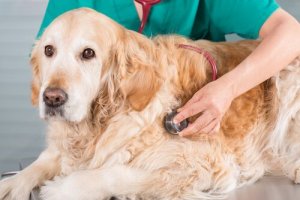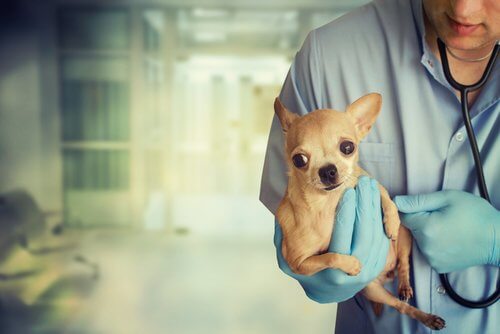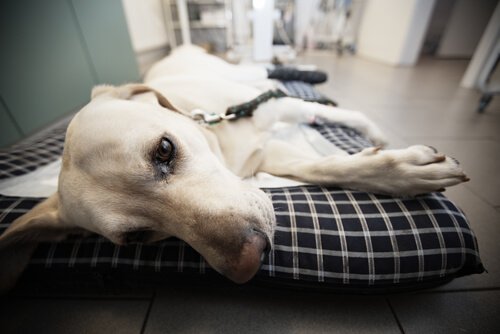What Should I Do if My Dog Has an Accident?


Written and verified by the lawyer Francisco María García
There’s always a risk that your dog could be involved in a car accident, and get concussed, wounded, or even fracture some bones. Accidents can even happen on your daily walks with your dog. That’s why you need to know how to act when your dog has an accident, in order to possibly save your pet’s life before rushing him to the vets.
After an accident, you must put the dog on its right side and cover him with a blanket right away. A strong blow poses a significant risk to an animal’s life.
If he becomes unconscious, straighten his neck to allow air to enter. Then, open his mouth, and carefully try to pull his tongue out, in order to eliminate any other object that might be preventing air from flowing.

How can you check whether the dog is breathing? You can look to see if his chest is rising and falling. If you need to take his pulse, do it on the inner part of the hind legs. You must keep in mind that the normal beats per minute are 100 to 160, for a dog weighing under 13 kilos.
Count the number of heartbeats for 15 seconds, and multiply the number of pulsations by four to get the total number of heartbeats per minute. Repeat the process to make sure that you counted correctly.
Transferring an injured dog to the vet or an emergency center must be done very carefully. This is because it can be uncomfortable and painful for him, among other things. It’s a good idea to cover him with a blanket while he is being moved. If you are going to transport him by car, it’s not a good idea to put him on the floor. Sudden braking can make him suffer more.
Wounds, hemorrhages, and fractures
- In the case of hemorrhages, you must stop the bleeding as soon as possible. To do this, apply a cloth compress (cotton leaves traces of fibers) soaked in water. Once the bleeding has stopped, cut the hair around the wound so that it stays clean and enables the wound to heal faster. Then, go to the vets quickly.
- If another dog caused the wound by biting your dog, you’ll need to carefully clean the infected area in addition to cutting the hair around it. To do this, use warm water and a soft skin disinfectant. Then, apply antiseptic cream. If the wound is deep, you’ll have to go to the vets quickly.
- When there is a fracture, you must be very careful not to make any sudden movements. You can try to immobilize the injured area (if you have first aid knowledge) using a belt, a magazine, a piece of cloth, etc. If you don’t know what to do, you shouldn’t move the area, in order to avoid making the injury any worse.
- Drowning. If the animal is suffering after nearly drowning, the right way to lift it is by its hind legs. That way, you’ll get all the fluid out of its lungs. If you notice that it’s not breathing, revive it by pressing rhythmically on both sides of its thorax. A practical trick is to close the animal’s mouth tightly with one hand, and use the other hand to make a tube over his nostrils, and then blow through the tube.
Cases of poisoning

Dogs are also at risk of poisoning while outdoors. Signs of poisoning are clear: vomiting, dizziness, seizures, etc. They may even foam at the mouth.
First, you need to identify the poison, and take a sample to the vet. In the meantime, DON’T give the animal milk or water in order to dilute the poison.
If the toxic substance has already come into contact with the dog’s skin, wash it with lots of water so that he won’t ingest more poison if he licks himself. If necessary, you can even trim the dog’s hair.
Eye emergencies
While you take him for a walk, many dangers await your friend. They could be anything from grains of sand to pointy tree branches. If his eye is injured and the eyelid is closed, don’t force him to open it.
First aid kits if your dog has an accident
Make sure you have gloves, scissors, iodine, bandages, tape, a clinical thermometer, cotton balls, oxygenated water, rubbing alcohol, gauze, etc.
There’s always a risk that your dog could be involved in a car accident, and get concussed, wounded, or even fracture some bones. Accidents can even happen on your daily walks with your dog. That’s why you need to know how to act when your dog has an accident, in order to possibly save your pet’s life before rushing him to the vets.
After an accident, you must put the dog on its right side and cover him with a blanket right away. A strong blow poses a significant risk to an animal’s life.
If he becomes unconscious, straighten his neck to allow air to enter. Then, open his mouth, and carefully try to pull his tongue out, in order to eliminate any other object that might be preventing air from flowing.

How can you check whether the dog is breathing? You can look to see if his chest is rising and falling. If you need to take his pulse, do it on the inner part of the hind legs. You must keep in mind that the normal beats per minute are 100 to 160, for a dog weighing under 13 kilos.
Count the number of heartbeats for 15 seconds, and multiply the number of pulsations by four to get the total number of heartbeats per minute. Repeat the process to make sure that you counted correctly.
Transferring an injured dog to the vet or an emergency center must be done very carefully. This is because it can be uncomfortable and painful for him, among other things. It’s a good idea to cover him with a blanket while he is being moved. If you are going to transport him by car, it’s not a good idea to put him on the floor. Sudden braking can make him suffer more.
Wounds, hemorrhages, and fractures
- In the case of hemorrhages, you must stop the bleeding as soon as possible. To do this, apply a cloth compress (cotton leaves traces of fibers) soaked in water. Once the bleeding has stopped, cut the hair around the wound so that it stays clean and enables the wound to heal faster. Then, go to the vets quickly.
- If another dog caused the wound by biting your dog, you’ll need to carefully clean the infected area in addition to cutting the hair around it. To do this, use warm water and a soft skin disinfectant. Then, apply antiseptic cream. If the wound is deep, you’ll have to go to the vets quickly.
- When there is a fracture, you must be very careful not to make any sudden movements. You can try to immobilize the injured area (if you have first aid knowledge) using a belt, a magazine, a piece of cloth, etc. If you don’t know what to do, you shouldn’t move the area, in order to avoid making the injury any worse.
- Drowning. If the animal is suffering after nearly drowning, the right way to lift it is by its hind legs. That way, you’ll get all the fluid out of its lungs. If you notice that it’s not breathing, revive it by pressing rhythmically on both sides of its thorax. A practical trick is to close the animal’s mouth tightly with one hand, and use the other hand to make a tube over his nostrils, and then blow through the tube.
Cases of poisoning

Dogs are also at risk of poisoning while outdoors. Signs of poisoning are clear: vomiting, dizziness, seizures, etc. They may even foam at the mouth.
First, you need to identify the poison, and take a sample to the vet. In the meantime, DON’T give the animal milk or water in order to dilute the poison.
If the toxic substance has already come into contact with the dog’s skin, wash it with lots of water so that he won’t ingest more poison if he licks himself. If necessary, you can even trim the dog’s hair.
Eye emergencies
While you take him for a walk, many dangers await your friend. They could be anything from grains of sand to pointy tree branches. If his eye is injured and the eyelid is closed, don’t force him to open it.
First aid kits if your dog has an accident
Make sure you have gloves, scissors, iodine, bandages, tape, a clinical thermometer, cotton balls, oxygenated water, rubbing alcohol, gauze, etc.
All cited sources were thoroughly reviewed by our team to ensure their quality, reliability, currency, and validity. The bibliography of this article was considered reliable and of academic or scientific accuracy.
Caloni, F., Cortinovis, C., Rivolta, M., & Davanzo, F. (2012). Animal poisoning in Italy: 10 years of epidemiological data from the Poison Control Centre of Milan. Veterinary Record. http://doi.org/10.1136/vr.100210
Cortinovis, C., Pizzo, F., & Caloni, F. (2015). Poisoning of dogs and cats by drugs intended for human use. Veterinary Journal. http://doi.org/10.1016/j.tvjl.2014.11.004
Shuler, C. M., DeBess, E. E., Lapidus, J. A., & Hedberg, K. (2008). Canine and human factors related to dog bite injuries. Journal of the American Veterinary Medical Association. http://doi.org/10.2460/javma.232.4.542
Stafford, J. R., & Bartges, J. W. (2013). A clinical review of pathophysiology, diagnosis, and treatment of uroabdomen in the dog and cat. Journal of Veterinary Emergency and Critical Care. http://doi.org/10.1111/vec.12033
This text is provided for informational purposes only and does not replace consultation with a professional. If in doubt, consult your specialist.








